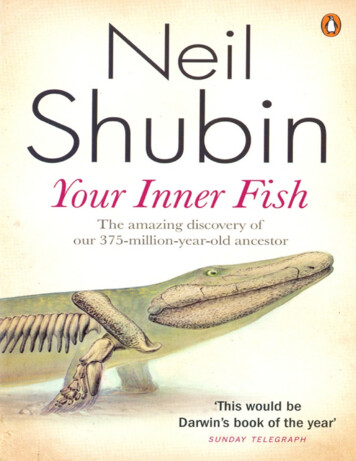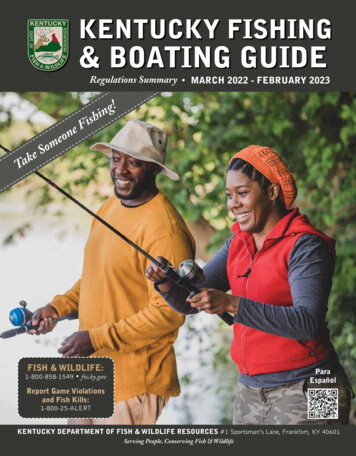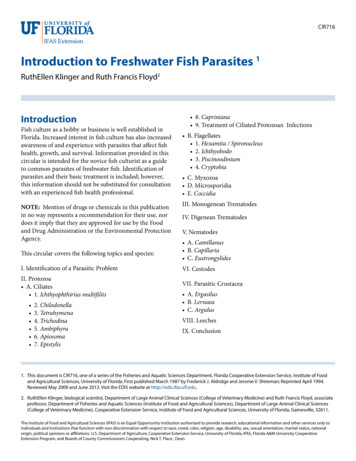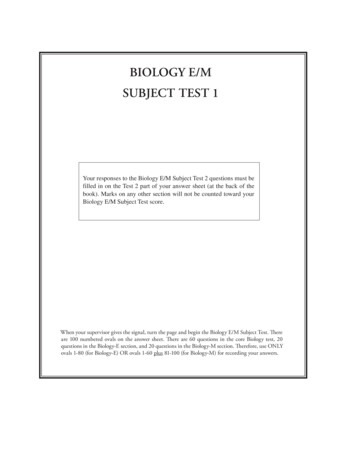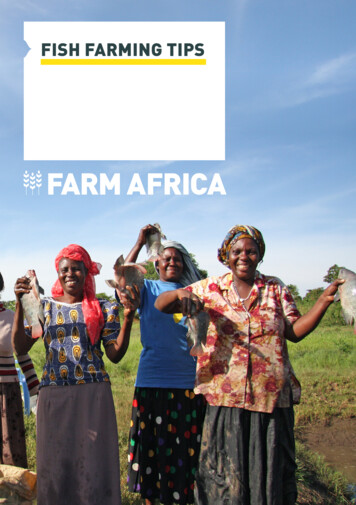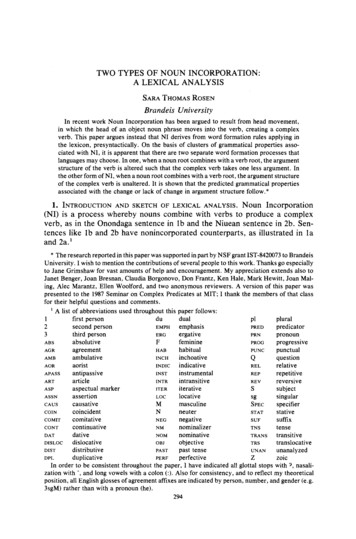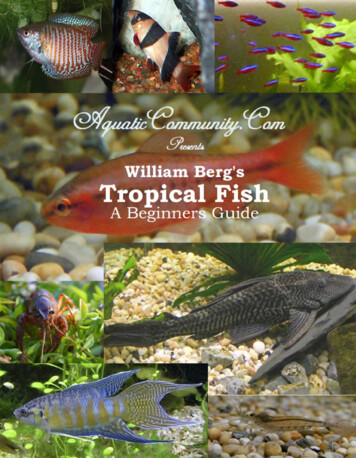
Transcription
HANDBOOK OF FISH BIOLOGY AND FISHERIESVolume 1
Also available from Blackwell Publishing:Handbook of Fish Biology and FisheriesEdited by Paul J.B. Hart and John D. ReynoldsVolume 2 Fisheries
Handbook of Fish Biologyand FisheriesVOLUME 1F I S H B I O LO G YEDITED BYPaul J.B. HartDepartment of BiologyUniversity of LeicesterANDJohn D. ReynoldsSchool of Biological SciencesUniversity of East Anglia
2002 by Blackwell Science Ltda Blackwell Publishing companyChapter 8 British Crown copyright, 1999BLACKWELL PUBLISHING350 Main Street, Malden, MA 02148‐5020, USA108 Cowley Road, Oxford OX4 1JF, UK550 Swanston Street, Carlton, Victoria 3053, AustraliaThe right of Paul J.B. Hart and John D. Reynolds to be identified as the Authorsof the Editorial Material in this Work has been asserted in accordance with theUK Copyright, Designs, and Patents Act 1988.All rights reserved. No part of this publication may be reproduced, stored in a retrievalsystem, or transmitted, in any form or by any means, electronic, mechanical,photocopying, recording or otherwise, except as permitted by the UK Copyright,Designs, and Patents Act 1988, without the prior permission of the publisher.First published 2002Reprinted 2004Library of Congress Cataloging‐in‐Publication Data has been applied for.Volume 1 ISBN 0‐632‐05412‐3 (hbk)Volume 2 ISBN 0‐632‐06482‐X (hbk)2‐volume set ISBN 0‐632‐06483‐8A catalogue record for this title is available from the British Library.Set in 9/11.5 pt Trump Mediaevalby SNP Best‐set Typesetter Ltd, Hong KongPrinted and bound in the United Kingdomby TJ International Ltd, Padstow, Cornwall.The publisher’s policy is to use permanent paper from mills that operate a sustainableforestry policy, and which has been manufactured from pulp processed using acid‐free andelementary chlorine‐free practices. Furthermore, the publisher ensures that the text paperand cover board used have met acceptable environmental accreditation standards.For further information onBlackwell Publishing, visit our website:http://www.blackwellpublishing.com
ContentsList of Contributors, xPreface, xiiList of Abbreviations, xiv1 BANISHING IGNORANCE: UNDERPINNING FISHERIES WITHBASIC BIOLOGY, 1Paul J.B. Hart and John D. Reynolds1.11.21.31.41.51.61.71.81.9Part 1:Introduction, 1Global fisheries, 1The quest for knowledge, 3Part 1: Biodiversity, 4Part 2: Production and population structure, 5Part 3: Fish as predators and prey, 7Part 4: Fish in ecosystems, 8Ignorance banished?, 9Conclusions, 10Biodiversity, 132 PHYLOGENY AND SYSTEMATICS OF FISHES, 15A.C. Gill and R.D. Mooi2.12.22.32.4Introduction, 15Phylogenetic methods and classification, 15Fish diversity and phylogeny, 20Conclusions, 363 HISTORICAL BIOGEOGRAPHY OF FISHES, 43R.D. Mooi and A.C. Gill3.13.23.33.4Introduction, 43Concepts and methods, 44Distribution, faunal composition and historical biogeography by region, 47Conclusions, 62
viContentsPart 2: Production and Population Structure, 694 THE PHYSIOLOGY OF LIVING IN WATER, 71Ole Brix4.14.24.34.44.54.64.74.8Introduction, 71Buoyancy, or coping with pressure, 72Swimming, 75Osmoregulatory problems in fresh and salt water, 78Respiration and special adaptations for living in low oxygen, 82Digestion and absorption, 90Bioluminescence, 91Conclusions, 925 ENVIRONMENTAL FACTORS AND RATES OF DEVELOPMENTAND GROWTH, 97Malcolm , 97Terminology of life-history stages, 97Development and growth during early life history, 99Growth models and equations, 102Age determination, back-calculation and validation techniques, 104Length–weight relationships and indices of condition and growth, 107Energy budget and bioenergetics: energy partitioning and storage, 109Growth at different latitudes: models of growth compensation, 113Estimating food consumption, 115Conclusions, 1176 RECRUITMENT: UNDERSTANDING DENSITY-DEPENDENCE INFISH POPULATIONS, 123Ransom A. Myers6.16.26.36.46.56.66.76.86.96.10Introduction, 123The link between spawner abundance and subsequent recruitment, 124Generalities through meta-analysis, 129Carrying capacity, 130Variability in recruitment, 131At what life-history stage does density-dependent mortality occur?, 131Estimating density-dependent mortality from long-term surveys, 133Pelagic egg, larval and juvenile stages, 136Future research, 141Conclusions, 144
Contents7 LIFE HISTORIES OF FISH, 149J.A. Hutchings7.17.27.37.47.57.6Introduction, 149Influence of survival and growth rate on age, size and reproductive effort at maturity, 152Offspring size and number strategies ,158Alternative life-history strategies, 162Effects of fishing on life history, 165Conclusions, 1678 MIGRATION, 175Julian Metcalfe, Geoff Arnold and Robert McDowall8.18.28.38.48.58.68.78.8Introduction, 175Exploitation and ecology, 178Fish migrations, 179Migratory mechanisms, 189Techniques, 191Distribution and genetics, 192Fishery applications, 194Conclusions, 1949 GENETICS OF FISH POPULATIONS, 200Robert D. Ward9.19.29.39.49.59.69.7Introduction, 200Genetic tools, 200Statistical tools, 205Specimen and species identification, 206Fish population genetics, 207Genetics of sex determination in fish, 218Conclusions, 21810 BEHAVIOURAL ECOLOGY OF REPRODUCTION IN FISH, 225Elisabet Forsgren, John D. Reynolds and Anders Berglund10.110.210.310.410.510.610.710.8General introduction, 225Introduction to breeding systems, 225Parental care, 228Sexual selection, 230Mating patterns, 236Reproductive behaviour and life histories, 238Reproductive behaviour and exploitation, 239Conclusions, 241vii
viiiContentsPart 3:Fish as Predators and Prey, 24911 FISH FORAGING AND HABITAT CHOICE: A THEORETICALPERSPECTIVE, 251Gary G. Mittelbach11.111.211.311.411.511.6Introduction, 251Foraging behaviour and diet choice, 252Foraging models and fish growth, 254Feeding rate and group size, 255Foraging and habitat selection, 256Conclusions, 26212 FEEDING ECOLOGY OF PISCIVOROUS FISHES, 267Francis Juanes, Jeffrey A. Buckel and Frederick S. tion, 267Adaptations for piscivory, 267Components of predation, 271Prey type and size selectivity, 274Predator-size and prey-size relationships, 275Population regulation, 277Methods of studying predation in the field, 278Implications for conservation and management, 279Conclusions, 27913 FISH AS PREY, 284J. Krause, E.M.A. Hensor and G.D. Ruxton13.113.213.313.4Part 4:Introduction, 284Immobility, 285Mobility, 287Conclusions, 293Fish in Ecosystems, 29914 TROPHIC ECOLOGY AND THE STRUCTURE OF MARINEFOOD WEBS, 301Nicholas V.C. Polunin and J.K. Pinnegar14.114.214.314.414.5Introduction, 301Food chains and food webs, 302Interaction strength in food webs, 312Implications of food webs and trophodynamics for fish and fisheries science, 314Conclusions, 316
Contents15 COMMUNITY ECOLOGY OF FRESHWATER FISHES, 321Lennart Persson15.115.215.315.415.515.615.7Introduction, 321Community patterns and basic ecological performance, 322Competition and predation as structuring forces, 325Fish community structure, productivity and habitat structure, 328Effects of fish on lower trophic components, 331From individual-level processes to population dynamics, 334Conclusions, 33716 COMPARATIVE ECOLOGY OF MARINE FISH COMMUNITIES, 341K. Martha M. Jones, Dean G. Fitzgerald and Peter F. Sale16.116.216.316.416.516.6Introduction, 341Biodiversity, 342Habitat associations, 346Differences in tropical and temperate production cycles, 350Variation in recruitment dynamics, 351Conclusions, 35217 INTERACTIONS BETWEEN FISH, PARASITES AND DISEASE, 359I. Barber and R. , 359Fish parasite diversity, 360Evolution of host–parasite relationships, 365Effects of parasites on fish population ecology, 374Socioeconomic and human health implications of fish parasites, 376Controlling parasite infections, 382Recent applications of fish parasitology, 383Conclusions, 384Index, 390ix
ContributorsGeoff ArnoldElisabet Forsgren Department of MarineEcology, Göteborg University, Kristineberg Marine Research Station, SE-450 34 Fiskebäckskil,Swedenelisabet.forsgren@kmf.gu.seI. BarberA.C. Gill The Natural History Museum,Cromwell Road, London SW7 5BD, UKt.gill@nhm.ac.ukThe Centre for Environment,Fisheries and Aquaculture Science, LowestoftLaboratory, Pakefield Road, Lowestoft, SuffolkNR33 0HT, UK.g.p.arnold@cefas.co.ukEdward Llwyd Building, Institute ofBiological Sciences, The University of WalesAberystwyth, Aberystwyth, SY23 3DA, UK.iab@aber.ac.ukAnders Berglund Animal Ecology, Evolutionary Biology Centre, Uppsala University, Norbyvägen 18 D, SE-752 36 Uppsala, SwedenAnders.Berglund@ebc.uu.seOle Brix Department of Zoology, University ofBergen, Allégaten 41, N-5007 Bergen, Norwayole.brix@zoo.uib.noPaul J.B. Hart Department of Biology,University of Leicester, Leicester LE1 7RH, UKpbh@leicester.ac.ukE.M.A. HensorSchool of Biology, Universityof Leeds, Leeds LS2 9JT, UKlizhensor@hotmail.comJ.A. Hutchings Department of Biology,Dalhousie University, Halifax, NS B3H 4J1,CanadaJeff.Hutchings@Dal.CaJeffrey A. Buckel Department of Zoology,Center for Marine Sciences and Technology, NorthCarolina State University, 303 College Circle,Morehead City, NC 28557, USAjeffrey buckel@ncsu.eduMalcolm Jobling The Norwegian College ofFishery Science, University of Tromsø, N-9037Tromsø, Norwaymalcolmj@nfh.uit.noDean G. FitzgeraldK. Martha M. JonesDepartment of NaturalResources, Biological Field Station, Cornell University, 900 Shackelton Point Road, Bridgeport,NY 13030, USAdf59@cornell.eduInstitute of Marine andCoastal Sciences, Rutgers University MarineField Station, 800 c/o 132 Great Bay Boulevard,Tuckerton, NJ 08087, USAmjones@imcs.rutgers.edu
ContributorsFrancis Juanes Department of etts, Amherst, MA 01003-4210, USAjuanes@forwild.umass.eduJ. Krause School of Biology, University ofLeeds, Leeds LS2 9JT, UKJ.Krause@leeds.ac.ukRobert McDowallxiJ.K. PinnegarThe Centre for Environment,Fisheries and Aquaculture Science, LowestoftLaboratory, Pakefield Road, Lowestoft, SuffolkNR33 0HT, UKj.k.pinnegar@cefas.co.ukNicholas V.C. PoluninDepartment of MarineSciences and Coastal Management, University ofNewcastle, Newcastle upon Tyne, NE1 7RU, UKn.polunin@ncl.ac.ukNational Institute ofWater and Atmospheric Research, PO Box 8602,Christchurch, New Zealandr.mcdowall@niwa.cri.nzR. PoulinJulian Metcalfe The Centre for Environment,Fisheries and Aquaculture Science, LowestoftLaboratory, Pakefield Road, Lowestoft, SuffolkNR33 0HT, UKj.d.metcalfe@cefas.co.ukJohn D. Reynolds School of BiologicalSciences, University of East Anglia, Norwich NR47TJ, UKReynolds@uea.ac.ukGaryG.MittelbachKellogg BiologicalStation, Michigan State University, HickoryCorners, MI 49060, USAmittelbach@kbs.msu.eduR.D. MooiMilwaukee Public Museum, 800West Wells Street, Milwaukee, WI 53233-1478,USAmooi@mpm.eduRansom A. MyersKillam Chair of OceanStudies, Department of Biology, Dalhousie University, Halifax, NS B3H 4J1, CanadaRansom.Myers@Dal.CaLennart Persson Department of Ecology andEnvironmental Science, Animal Ecology, UmeåUniversity, SE-901 87 Umeå, Swedenlennart.persson@eg.umu.seDepartment of Zoology, Universityof Otago, PO Box 56, Dunedin, New Zealandrobert.poulin@stonebow.otago.ac.nzG.D. RuxtonDivision of Environmental andEvolutionary Biology, Graham Kerr Building,Glasgow University, Glasgow G12 8QQ, UKg.ruxton@bio.gla.ac.ukPeter F. Sale Department of Biology and GreatLakes Institute for Environmental Research, University of Windsor, Windsor, Ontario N9B 3P4,Canadasale@uwindsor.caFrederick S. Scharf Northeast Fisheries Science Center, James J. Howard Marine SciencesLaboratory, 74 Magruder Road, Sandy Hook,Highlands, NJ 07732, USAFred.Scharf@noaa.govRobert D. WardCSIRO Research, PO Box1538, Hobart, Tasmania 7001, Australiabob.ward@marine.csiro.au
PrefaceThe goal of the two volumes of the Handbook ofFish Biology and Fisheries is to help integrate thestudy of fish biology with the study of fisheries.One might not expect these two subjects to needfurther integration. However, strong declines inmany fish stocks around the globe, combined withgrowing concerns about the impact of fisherieson marine and freshwater biodiversity, are raisingnew questions about aspects of fish biology thathave traditionally dwelt outside mainstreamfisheries research. Thus, fisheries biologists andmanagers are increasingly asking about aspectsof ecology, behaviour, evolution and biodiversitythat had traditionally been studied by differentpeople who attend different conferences and publish in different journals. By bringing these peopleand their subjects together in the two volumes ofthis Handbook, we hope to foster a better two-wayflow of information between the studies of fishbiology and fisheries.A tradition runs through the prefaces of theother volumes in this series whereby the editorsdistance themselves from a literal translation ofthe word ‘Handbook’. In keeping with this tradition, we wish to make clear that this is not a cookbook of recipes for how to study and manage fishpopulations. Instead, we have tried to produce apair of reference books that summarize what isknown about fish biology and ecology, much ofwhich is relevant to assessment and managementof fish populations and ecosystems. Of course,much of the material in the first volume may neverfind applications in fisheries, and that is fine withus. We encouraged our authors to provide a widecoverage of fish biology simply because the topicsare interesting in their own right, and becausethe borders between pure and applied research arefuzzy. We therefore decided not to restrict information according to its direct relevance to fisheries as this subject is understood today. We hopethe result will be of value to undergraduates andgraduates looking for information on a wide variety of topics in fisheries science. The books are alsoaimed at researchers who need up-to-date reviewsof topics that impinge on their research field butmay not be central to it. The information shouldalso be useful to managers and decision makerswho need to appreciate the scientific backgroundto the resources they are trying to manage andconserve.In the first volume, subtitled Fish Biology, ourintroductory chapter explores the underpinningsof fisheries biology and management by basicresearch on fish biology. Part 1 then examinessystematics and biogeography of fishes, includingmethods for determining phylogenetic relationships and understanding spatial patterns of diversity. Part 2 examines production and populationstructures of fishes, beginning with chapters onphysiology and growth, followed by recruitment,life histories, migration, population structure andreproductive ecology. Part 3 considers fishes aspredators and as prey, making use of conceptualadvances in behavioural ecology to link predator–prey interactions to the environment. In Part4 we scale up from individual interactions tocommunities and ecosystems. The chaptersinclude comparisons of freshwater and marine
Prefacecommunities, as well as interactions betweenfishes and parasites.In the second volume, subtitled Fisheries, webegin with a chapter that considers the humandimension of fisheries management. Part 1 thengives background information for fisheries, including fishing technology, marketing, history offisheries, and methods of collecting and presenting data. Part 2 provides fundamental methods ofstock assessment, including surplus productionmodels, virtual population analyses, methods forforecasting, length-based assessments, individualbased models and economics. We have also triedto consolidate this information by reviewing thevarious options available for modelling fisheries,including the pros and cons of each. Part 3 exploreswider issues in fisheries biology and management,including the use of marine protected areas, conservation threats to fishes, ecosystem impacts andrecreational fishing.We are very grateful to our 54 authors from 10countries for their hard work and patience whilewe attempted to herd them all in the same generaldirection. We also thank Susan Sternberg who firstsuggested that we take on this project, and DeliaxiiiSandford at Blackwell Science who has overseen it.The final stages of production have been greatlyhelped by two people. Valery Rose of LongworthEditorial Services worked patiently and efficientlyto shepherd the book through the copy editing andproduction stages, and Monica Trigg, did an excellent job with the gargantuan task of constructingthe two indices. Paul Hart would like to thank theUniversity of Bergen, Department of Fisheries andMarine Biology, for providing him with space andsupport during the final editing of the manuscript.John Reynolds would like to thank his many colleagues at the University of East Anglia and at theCentre for Environment, Fisheries, and Aquaculture Science (Lowestoft) who have helped buildbridges between pure and applied research.The editors and publishers are grateful to copyright holders for providing permission to reproduce copyright material. If any sources have beeninadvertently overlooked, the publishers willbe pleased to rectify this omission at the firstopportunity.Paul J.B. Hart and John D. ReynoldsLeicester and Norwich
RMIFDJAMMPAMSAamplified fragment lengthpolymorphismcatch per unit effortcoefficient of variationexon-primed intron-crossing PCRenvironmental sex determinationFood and AgricultureOrganizationglomerular filtration rategonadosomatic indexindices of biotic integrityInternational Council for theExploration of the SeasInternational Center for LivingAquatic Resources Managementideal free distributionjudicious averaging methodmarine protected areamixed stock CMCWRIYOYmultispecies virtualpopulation analysisnucleotide triphosphatesoptimal foraging theorypolymerase chain reactionrandomly amplifiedpolymorphic DNArestriction fragment lengthpolymorphismrespiratory quotientshort-chain fatty acidssingle-species virtualpopulation analysistrimethylamine oxidevon Bertalanffy growth functionWorld ConservationMonitoring CentreWorld Resources Instituteyoung of the year
1 Banishing Ignorance:Underpinning Fisheries withBasic BiologyPAUL J.B. HART AND JOHN D. REYNOLDS1.1INTRODUCTIONTourists mingle with local people among thestalls set out by Zachariasbryggen, Bergen,Norway. Young men and women in bright orangeoilskin overalls, fluent in several languages, sellfresh crabs (Cancer pagurus), lobsters (Homarusgammarus), mackerel (Scomber scombrus), cod(Gadus morhua) and farmed salmon (Salmo salar)to Japanese, German, British, American and Dutchtourists. People from Bergen buy their supper asthey pass by during their lunch break. Unseenby the mill of tourists and locals are the fisherswho started from port at four in the morning to settheir nets, go trawling or lift their crab pots. If youtravel about a kilometre along the western shore ofVågen, the bay surrounded by the centre of Bergen,you come to Nordnes, the location of the Institutefor Marine Research, the public aquarium and theoffices of the Norwegian Fisheries Ministry. Thetall building is full of biologists working on fishstock assessments and on research into the marineenvironment. At the Fisheries Ministry the coastguard and fisheries officers plan and execute monitoring programmes and quota allocations. On theother side of Vågen can be found the Bergen Fisheries Museum as well as the warehouses and factories of fish processing and distribution firms. Onthe southern edge of the city centre, scientists inthe Department of Fisheries and Marine Biologyof the University of Bergen are researching theecology of marine organisms, work that underpinsthe conservation of biodiversity. This area ofBergen, covering perhaps 2 km2, contains all the elements of the community that the two volumes ofthis book are designed to serve. In other parts of theworld the various institutions of fisheries are notas close to each other as they are in Bergen but theelements will be some local version of what existsaround Vågen. The heart of the system is the fisherand the market at which the produce is landed andsold.1.2GLOBAL FISHERIESAccording to the United Nations Food andAgricultural Organization (FAO), there was asteady increase of fish catches until the middle ofthe 1990s when the catch began to level off (Fig.1.1). Recent work by Watson and Pauly (2001) hasshown that in reality the total marine catch of fishhas been declining by some 10% a year since 1988.The apparent continued increase until the mid1990s was due to inflated catch statistics reportedby China, the world’s biggest fishing nation. Thiswas thought to be due to local managers beingunder pressure to show increased production tomeet the goals of a centralized communisteconomy. FAO estimates that 47–50% of theworld’s fish stocks are fully exploited, 15–18%overexploited and 9–10% depleted (FAO 2000). Adrop in fisheries production in 1998 was primarilydue to the El Niño event that took place in 1997–8.This influenced most directly the SoutheastPacific region, one of the regions that contributes
2Chapter 1140AquacultureCapture fisheries120Million tonnes10080604020050 953 956 959 962 965 968 971 974 977 980 983 986 989 992 995 9981 1 1 11 11 1 11 1 1 1 1 1119most to the catch of marine fish, mainly anchovy(Engraulis ringens) and Chilean jack mackerel(Trachurus murphyi) (Fig. 1.2).As shown in Table 1.1, the catch of fish taken bycapture fisheries in inland waters continued togrow between 1994 and 1999. In 1999 about 27 million fishers landed 92 million tonnes of fish andshellfish. A further 9 million people were busy producing 32 million tonnes of farmed fish. International trade in fisheries commodities was worthsome US 53.4 billion in 1999. The marine fishingfleet consisted of around 23 014 vessels over 100tonnes. In reality there are probably at least asmany vessels again under this quite large lowerweight limit. The fish caught by all these vesselsand people were processed and sold in a variety ofways. In 1998, the latest year for which data areavailable, 79.6% of fish landed was used for directhuman consumption while the remainder wentinto non-food production. Of the proportion beingused directly as human food, 45.3% was sold fresh,28.8% was frozen, 13.9% was canned and 12%was cured. Fifty years ago the proportion that wasfrozen would have been much smaller and the partcured or canned much higher.Fish form an important part in the diet of manypeople. Average consumption per head has grownconsiderably over the past 40 years, increasingfrom 9 kg per person per year in the early 1960s toFig. 1.1 Global landings of marineand inland capture fisheries andaquaculture. Data from 1970corrected for misreporting ofmarine landings (Watson andPauly, 2001; R. Watson, personalcommunication). (Source: fromFAO 2000.)Altantic, Southwest2.32.5Pacific, Northwest2.82.9Atlantic,Eastern Central199819963.63.5Indian Ocean,Western3.94.1Indian Ocean,Eastern4.03.95.04.5Asia, Inland waters8.0Pacific, Southwest17.19.38.8Pacific, WesternCentral10.911Atlantic, Northwest24.823.5Pacific, Northwest051015202530Million tonnesFig. 1.2 Capture fisheries production by major fishingregions in 1996 and 1998. (Source: from FAO 2000.)
3Underpinning Fisheries with Basic BiologyTable 1.1 Recent trends in world fisheries production and utilization. The data in this table are given withoutcorrection for the inflated catches documented by Watson and Pauly (2001). (Source: from FAO 2000.)199419951996199719981999Production (million tonnes)InlandCaptureAquacultureTotal l 93.928.55.816.193.323.95.915.892.630.46.015.4Total captureTotal aquacultureTotal world fisheriesUtilizationHuman consumption (million tonnes)Reduction to fishmeal and oil (million tonnes)Human population ( 109)Per-capita food fish supply (kg)16 kg per person per year in 1997 (FAO 2000; Table1.1). In developed countries consumption per headover the same period has risen from 19.7 to 27.7 kgper year. Countries at the other end of the wealthscale have much less fish available, although theytoo have experienced a rise in supply from 4.9 to7.8 kg per person per year. In poor countries fishcan form 20% of a person’s protein intake. Africancountries have access to much less fish than docountries in Southeast Asia (excluding China).1.3 THE QUESTFOR KNOWLEDGEWhen T.H. Huxley made his infamous remarks in1883 about fish being too fecund for their numbersever to be influenced by fishing, he was showingsupreme confidence in his knowledge of fish andtheir biology. This confidence meant that othershad to work hard to collect information before hecould be proven wrong (see Smith, Chapter 4, Volume 2). We now realize that uncertainty about fishbiology and fishing systems is inherent and has tobe taken into account at all times. Uncertaintycomes in different forms and has been categorizedby Charles (1998) into three types: (i) random fluctuations, (ii) uncertainty in parameters and statesof nature and (iii) structural uncertainty. The lattercan be put more bluntly as ignorance; we just donot know how the system works. Ecology is a difficult subject, especially when the species understudy is not easy to see and its population dynamics display unpredictable fluctuations, a phenomenon widespread in the natural world. Uncertaintyin parameters and in the state of nature can now beembraced by various estimation procedures, ranging from simulation methods to Bayesian statistics to fuzzy logic (Wade 2001). When all else fails,we may have to tackle structural uncertainty bylearning more about the system.The first volume of this book reviews the extentof our knowledge about many aspects of fishbiology, while the second volume integrates thisknowledge with descriptions of a wide range oftopics in fisheries biology and management, fromhow fish are caught to methods for assessing theirpopulations and predicting impacts of exploitation
4Chapter 1on the targeted species and their ecosystems. In effect, the first volume tries to show what we knowand to demarcate the limits of structural uncertainty about basic biology. Along the way the authors also show the degree to which our knowledgeis plagued by the other two sources of uncertainty.Some of the chapters inevitably overlap and thedifferent viewpoints on the same part of nature arereminiscent of a passage from John Steinbeck’s(1952) foreword to Between Pacific Tides by hisfriend Ed Ricketts. He wrote: ‘There are goodthings to see in the tidepools and there are excitingand interesting thoughts to be generated from theseeing. Every new eye applied to the peep holewhich looks at the world may fish in some newbeauty and some new pattern, and the world of thehuman mind must be enriched by such fishing.’We think that these different viewpoints areimportant as they illustrate how there is oftennot enough known of an ecosystem or species toallow a definitive account to be given.Structural uncertainty is meat and drink tothe scientist. Problems are rarely solved entirely,because we are always uncovering new layers ofcomplexity. The view is often expressed that wereally need to do more research on this or thatproblem so that we can better understand what isgoing on and therefore be in a better position tomanage it. To a point this is true, but as Ludwiget al. (1993) wrote:Recently some of the world’s leading ecologists have claimed that the key to a sustainable biosphere is research on a long list ofstandard research topics in ecology. Such aclaim that basic research will (in an unspecified way) lead to sustainable use of resourcesin the face of a growing human populationmay lead to a false complacency: insteadof addressing the problems of populationgrowth and excessive use of resources, wemay avoid such difficult issues by spendingmoney on basic ecological research.There is a danger that those interested in fisheriesmanagement and conservation will not knowwhen to stop in the quest for more knowledge.These two volumes show that we do know a greatdeal about fish biology and ecology, yet the world’sfish stocks are still being reduced mercilessly. Theproblem is that knowing about the resource isnot enough. As Walters (1986) has said, fisheriesmanagement is more about managing people thanecosystems, a point that we return to in our introduction to the second volume.With two volumes composed of 34 chapterswritten by 54 people, we hope we have provided aholistic view of fisheries science. In this chapterwe want to draw attention to our reasons for including the chapters we have in the first volume. Inaddition we also try to show how the study of commercial fish populations has led to new insightsin many basic areas of biology and ecology. Theearly years of fisheries science created a disciplinethat was considered very separate from the restof biology (Graham 1956). The need to tacklepractical problems often made it hard for fisheriesscientists to contribute to the literature on basicecology. Despite this, scientists such as Hjort,Hardy, Beverton and Holt (see Smith, Chapter 4,Volume 2) left a lasting legacy in ecology as well asin the specialist field of fisheries.1.4PART 1: BIODIVERSITYThis volume starts with two accounts that tellus what fish there are, how we determine whichtaxa are related to one another, and where theycan be found (Gill and Mooi, Chapter 2; Mooi andGill, Chapter 3). These are fascinating studies intheir own right, and the information also underpins several aspects of fisheries science. For example, recent work that attempts to predict
15.4 Fish community structure, productivity and habitat structure, 328 15.5 Effects of fish on lower trophic components, 331 15.6 From individual-level processes to population dynamics, 334 15.7 Conclusions, 337 16 COMPARATIVE ECOLOGY OF MARINE FISH COMMUNITIES, 341 K. Martha M. Jones, Dean G. Fitzgerald and Peter F. Sale 16.1 Introduction, 341Cited by: 204Publish Year: 2002Author: Paul J. B. Hart, John D. ReynoldsExplore furtherHANDBOOK OF FISH BIOLOGY AND FISHERIES Volume 1onlinelibrary.wiley.com(PDF) Handbook of Fish Biology and Fisheries, Volume 2 .www.researchgate.net(PDF) Modelling and interpreting fish bioenergetics: A .www.researchgate.net(PDF) Biology, Fishery, Conservation and Management of .www.researchgate.netFree eBooks: Fish & Fisheries (Kindle Nook iPad PDF EPub .www.digitalbookindex.orgRecommended to you b
